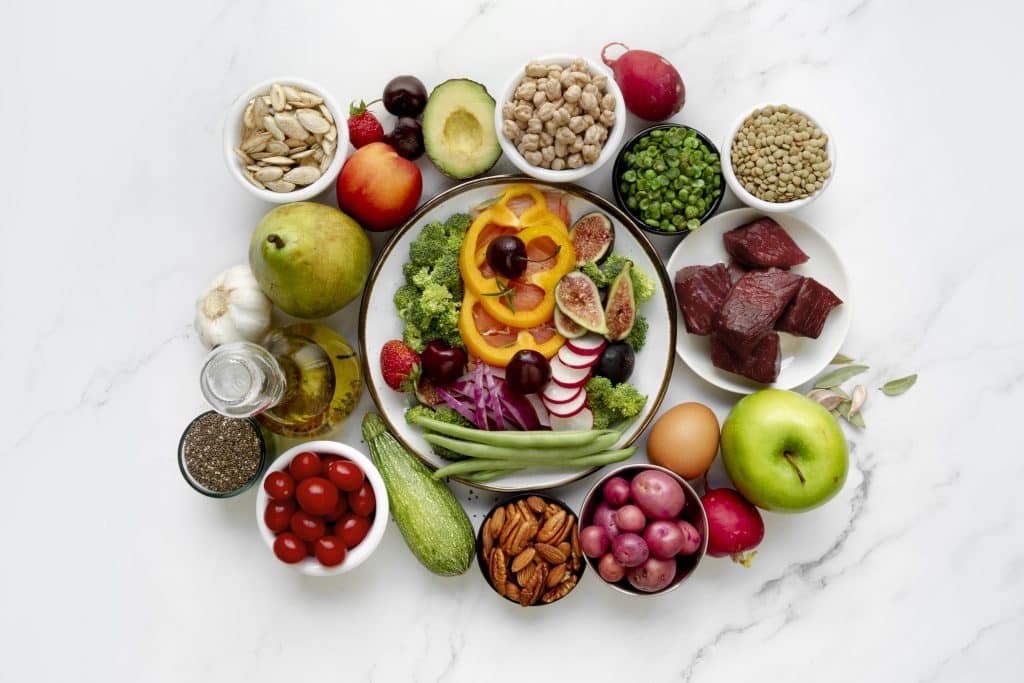Nutrition and Healthy Eating: to Transform Your Health
Por: katia alves em agosto 20, 2025

Taking care of your diet goes far beyond aesthetics or trendy diets. Healthy nutrition is the foundation for having energy, focus, preventing diseases, and living a better life. In today’s fast-paced world, where processed foods and convenience meals dominate, learning how to make smart food choices is one of the best investments you can make for your well-being.
In this article, you’ll discover everything about nutrition and healthy eating: benefits, essential foods, common mistakes, practical tips, and even a simple guide to building balanced plates at home.
🍎 What Is Healthy Eating?
Healthy eating is more than just following a temporary diet trend—it’s a long-term lifestyle that focuses on nourishing your body with the right foods. At its core, it is a dietary pattern that emphasizes fresh, varied, and nutrient-rich foods while reducing excess sugar, unhealthy fats, and highly processed products.
A truly healthy diet includes diversity: fruits, vegetables, whole grains, lean proteins, and healthy fats. Each food group plays a unique role, from providing energy to strengthening your immune system and supporting mental well-being. By combining these groups in the right amounts, you create a balanced foundation for both physical and emotional health.
Importantly, healthy eating does not mean restriction or deprivation. It’s not about banning your favorite foods, but about balance: eating a little bit of everything in the right proportions. For example, enjoying a slice of cake occasionally doesn’t make your diet unhealthy—what matters is the consistency of your daily choices.
Key Principles of Healthy Eating
-
Variety: Eating a wide range of foods to cover all nutrient needs.
-
Moderation: Controlling portion sizes and avoiding overconsumption.
-
Quality: Choosing fresh, whole, and minimally processed foods.
-
Consistency: Building sustainable habits that can last a lifetime.
Why Healthy Eating Matters
When you prioritize whole, nutrient-dense foods, you support every system in your body:
-
Energy and vitality: Steady fuel for daily tasks and workouts.
-
Disease prevention: Lower risk of obesity, diabetes, heart disease, and more.
-
Mental health: Proper nutrition enhances mood and reduces stress.
-
Longevity: A healthy diet contributes to a longer, more active life.
🥗 The Pillars of Healthy Nutrition

To truly understand nutrition, it helps to break it down into core principles. These pillars form the foundation of a diet that not only fuels your body but also protects your long-term health.
1. Variety
No single food can provide all the nutrients your body needs. That’s why variety is essential in nutrition. By consuming different food groups—fruits, vegetables, whole grains, proteins, and healthy fats—you ensure a wider intake of vitamins, minerals, fiber, and antioxidants.
A simple trick is to build a colorful plate. Each color in fruits and vegetables represents unique phytochemicals that support different parts of the body. For example:
-
Orange foods (carrots, sweet potatoes) are rich in beta-carotene, which supports vision.
-
Green foods (spinach, broccoli) provide iron, calcium, and vitamin K for bone health.
-
Purple foods (blueberries, eggplant) contain antioxidants that protect cells from aging.
The more colors you eat, the stronger your nutrition foundation becomes.
2. Balance
Balance is the key to making nutrition sustainable. Instead of extreme restrictions, it’s about proportion. A balanced plate gives your body the right mix of macronutrients:
-
50% vegetables and greens → Rich in fiber, vitamins, and water for digestion and immunity.
-
25% lean protein → Builds and repairs muscles, supports metabolism.
-
25% healthy carbohydrates → Provides energy and keeps blood sugar stable.
Adding a small portion of healthy fats (like olive oil, avocado, or nuts) completes the equation, supporting brain and heart health.
This simple visual guide prevents overeating, reduces cravings, and ensures each meal is nutrient-dense without needing to count every calorie.
3. Quality
In nutrition, quality matters just as much as quantity. Choosing whole and minimally processed foods provides your body with natural nutrients, free from excess chemicals, preservatives, and empty calories.
-
High-quality carbs: brown rice, quinoa, oats (instead of refined flour or sugary snacks).
-
High-quality proteins: fish, eggs, beans, tofu (instead of processed meats like sausages).
-
High-quality fats: olive oil, seeds, nuts (instead of fried foods or hydrogenated oils).
By focusing on food quality, you get more nutritional value per bite while reducing exposure to harmful additives
🌟 Benefits of Healthy Nutrition

Adopting balanced eating habits provides benefits for your whole body:
-
More energy and focus: prevents blood sugar spikes.
-
Weight control: supports satiety and metabolism.
-
Disease prevention: lowers risk of diabetes, hypertension, and heart disease.
-
Mental health: magnesium- and omega-3-rich foods boost mood.
-
Stronger immunity: nutrients improve your natural defense system.
🥑 Essential Foods for a Healthy Diet
| Food Group | Examples | Benefits |
|---|---|---|
| Fruits & Vegetables | Apple, banana, kale, broccoli | Vitamins, fiber, antioxidants |
| Whole Grains | Oats, quinoa, brown rice | Long-lasting energy, satiety |
| Lean Proteins | Chicken, fish, eggs, lentils | Muscle maintenance, metabolism |
| Healthy Fats | Olive oil, avocado, nuts | Heart and brain health |
| Liquids | Water, teas, infused water | Hydration and detox |
🚫 What to Avoid or Limit
-
Refined sugar: found in sodas, sweets, and desserts.
-
Excess salt: causes fluid retention and high blood pressure.
-
Fried and trans fats: linked to heart disease.
-
Ultra-processed foods: packaged snacks, fast food, processed meats.
💡 Practical Tips for Everyday Life
-
Plan your meals: avoid relying on fast food.
-
Shop smarter: focus on fresh produce and whole foods.
-
Pack healthy snacks: fruit, yogurt, or mixed nuts.
-
Swap sodas for infused water with lemon or mint.
-
Cook at home whenever possible: you control sugar, salt, and fat.
🍴 The Healthy Plate Guide (Easy Method)

One of the simplest ways to practice better nutrition every day is by following the Healthy Plate method. Instead of obsessing over calorie counting or strict diets, this approach teaches you how to balance your meals visually. By dividing your plate into specific portions, you ensure that your body gets the right mix of nutrients without the stress of complicated rules.
How to Build a Balanced Plate
-
50% Vegetables and Greens
Fill half of your plate with colorful vegetables and leafy greens. They are rich in fiber, vitamins, minerals, and antioxidants that promote digestion, strengthen immunity, and help prevent chronic diseases. -
25% Lean Protein
Choose lean sources such as chicken, fish, eggs, tofu, or beans. Protein supports muscle growth, keeps you full for longer, and is essential for hormone and enzyme production. -
25% Complex Carbohydrates
Opt for whole-food carbs like sweet potato, brown rice, or quinoa. Unlike refined carbs, complex carbs provide long-lasting energy, stabilize blood sugar, and support brain health. -
1 Tablespoon of Healthy Fat
Add healthy fats such as olive oil, avocado, or nuts. They are crucial for heart health, brain function, and vitamin absorption.
Why This Method Works
This approach is inspired by the famous “Harvard Healthy Plate” method, created by nutrition experts to provide a simple, universal model for healthy eating. Unlike fad diets, it doesn’t eliminate food groups—it teaches balance.
By applying this method daily, you automatically:
-
Control portion sizes without needing to weigh food.
-
Improve digestion and metabolism.
-
Boost energy levels and reduce cravings.
-
Support long-term weight management naturally.
Practical Tips to Apply the Healthy Plate Guide
-
Use a medium-sized plate to avoid oversized portions.
-
Fill your plate with different colors—the more variety, the better the nutrition.
-
Prepare vegetables in multiple ways: raw, steamed, roasted, or sautéed.
-
Rotate protein sources between plant-based and animal-based for balance.
-
Limit sauces high in sugar and sodium—season instead with herbs, lemon, or olive oil.
Healthy Plate in Real Life
Here are a few quick examples of how a balanced plate might look:
-
Lunch: Grilled chicken, roasted sweet potato, and a large green salad with olive oil.
-
Dinner: Baked salmon, quinoa, steamed broccoli, and a small portion of avocado.
-
Vegetarian option: Lentils with brown rice, sautéed spinach, and roasted vegetables.
🧘 Nutrition and Mental Well-Being

When people think of nutrition, they often focus on physical health—muscle gain, weight loss, or energy levels. But food also plays a crucial role in mental health. What you eat can directly influence your mood, focus, stress levels, and even your risk of developing conditions like depression or anxiety.
The Nutrition–Brain Connection
Your brain requires a steady supply of nutrients to function properly. Just as poor nutrition can leave you feeling sluggish, nutrient-dense foods can enhance memory, concentration, and emotional stability. Research shows that diets rich in whole foods and low in processed products are associated with lower levels of anxiety and improved mental well-being.
Key Nutrients for Mental Health
-
Omega-3 fatty acids (fish, walnuts, chia seeds): These healthy fats are essential for brain cell function and have been linked to reduced depression symptoms and improved mood stability.
-
Tryptophan (banana, oats, cocoa, turkey): This amino acid supports serotonin production—the neurotransmitter known as the “happiness hormone.” Adequate tryptophan in your diet helps regulate sleep, mood, and appetite.
-
Magnesium (spinach, pumpkin seeds, almonds): Known as the “relaxation mineral,” magnesium helps regulate stress responses, promotes calmness, and supports better sleep.
-
B vitamins (whole grains, leafy greens, eggs): Vital for brain function, energy production, and reducing mental fatigue.
-
Antioxidants (berries, dark chocolate, green tea): Protect brain cells from oxidative stress, helping maintain cognitive sharpness over time.
How Nutrition Affects Stress and Anxiety
When the body is deprived of essential nutrients, it struggles to regulate hormones that influence emotions. High-sugar and ultra-processed diets can cause blood sugar spikes and crashes, leading to irritability, lack of focus, and increased stress. On the other hand, balanced nutrition with whole foods helps stabilize blood sugar, providing a steady flow of energy for both body and mind.
Building a Mind-Healthy Diet
To support your mental well-being through nutrition, try:
-
Including fatty fish or plant-based omega-3 sources twice a week.
-
Starting your day with serotonin-friendly foods like oats and bananas.
-
Adding leafy greens to at least two meals per day.
-
Reducing caffeine and replacing it with calming herbal teas.
-
Practicing mindful eating—focusing on the food experience instead of rushing meals.
-
📱 Technology to Support Your Nutrition

In the digital age, nutrition is no longer just about cooking at home or following traditional diet plans. Technology has become a powerful ally for those who want to eat better, track their progress, and build healthier habits. With just a smartphone, you can have access to personalized guidance, calorie counting tools, and reminders that help you stay consistent with your goals.
Why Use Apps for Nutrition?
Nutrition apps make it easier to:
-
Track daily calories and macronutrients.
-
Monitor vitamins, minerals, and hydration.
-
Create and follow personalized meal plans.
-
Develop awareness about eating habits.
-
Stay motivated with progress charts and reminders.
By combining traditional nutrition knowledge with modern technology, these apps allow users to make informed choices every day.
Popular Apps That Support Nutrition
-
MyFitnessPal: One of the most popular apps worldwide, offering a calorie counter and nutrition tracker. Its database has millions of foods, making it easy to log meals and monitor macronutrients.
-
Yazio: Focuses on personalized meal plans, ideal for those who want structure. It helps balance daily nutrition with weight-loss, muscle-gain, or maintenance goals.
-
NutraBem: Tailored for the Brazilian audience, this app suggests local recipes and meal options that match cultural eating habits while promoting balanced nutrition.
The Future of Digital Nutrition
As technology evolves, artificial intelligence and wearables are taking nutrition to the next level. Smartwatches and health trackers can now monitor hydration, sleep quality, and activity levels—data that syncs directly with apps to recommend better food choices. Imagine an app that analyzes your stress levels and suggests magnesium-rich meals, or that adjusts your daily calories based on real-time action.
-
-
🥤 Nutrition Myths vs. Facts

When it comes to nutrition, there are countless myths that can confuse anyone trying to eat healthier. Let’s break down some of the most common misconceptions and replace them with science-based facts:
❌ Myth 1: Do carbs make you fat?
Fact: Carbohydrates alone do not cause weight gain. What matters in nutrition is the balance between the calories you consume and the energy you burn. Whole-grain carbs such as oats, quinoa, and brown rice provide fiber, vitamins, and long-lasting energy. The problem arises with excessive refined carbs, like white bread and sugary snacks.
❌ Myth 2: Do detox juices make you lose weight?
Fact: No single food or juice has the power to burn fat. Good nutrition is about consistency, not quick fixes. While juices made with fruits and vegetables can add vitamins and antioxidants, weight management comes from overall lifestyle changes—balanced meals, regular exercise, hydration, and good sleep.
❌ Myth 3: Is all fat bad?
Fact: Fat is an essential macronutrient in human nutrition. The key is to focus on healthy fats, such as olive oil, avocado, nuts, and fatty fish. These support brain function, hormone balance, and heart health. What should be avoided are trans fats and heavily processed fried foods.
❌ Myth 4: Do I need to cut gluten to be healthy?
Fact: For most people, gluten is not harmful. Unless you have celiac disease or gluten intolerance, there’s no need to eliminate it from your diet. In fact, whole grains containing gluten—like whole wheat, barley, and rye—are rich in fiber and nutrients important for a balanced nutrition plan.
✅ Takeaway
Good nutrition is about balance, variety, and moderation. Instead of following diet fads or fear-based food rules, focus on whole, minimally processed foods, proper hydration, and sustainable habits that support long-term health
🥗 The Pillars of Healthy Nutrition
Good health starts with what you eat. While exercise, sleep, and lifestyle all matter, nutrition is the foundation that fuels your body and mind. Understanding the core pillars of healthy nutrition helps you build meals that provide energy, prevent disease, and support long-term well-being.
🥦 1. Variety
One of the most important principles in nutrition is variety. No single food can provide all the vitamins, minerals, and nutrients your body needs to thrive. That’s why a balanced diet should include fruits, vegetables, whole grains, lean proteins, and healthy fats.
A practical way to think about variety is the “eat the rainbow” strategy:
-
Red foods like tomatoes and strawberries → rich in vitamin C and lycopene, great for heart health.
-
Orange foods like carrots and sweet potatoes → loaded with beta-carotene, essential for vision and skin.
-
Green foods like broccoli and kale → high in iron, calcium, and folate, which support blood and bone health.
-
Blue and purple foods like blueberries and eggplant → antioxidants that protect memory and slow aging.
The more colors you add to your plate, the more complete your nutrition becomes.
⚖️ 2. Balance
Healthy nutrition is not about cutting out food groups, but about proportion. A well-balanced plate ensures your body gets the right amount of macronutrients:
-
50% vegetables and greens → rich in fiber and micronutrients.
-
25% lean protein → supports muscle repair, metabolism, and hormones.
-
25% healthy carbohydrates → whole grains for energy and brain function.
-
A small portion of healthy fat → olive oil, avocado, or nuts for heart and brain health.
This balance prevents overeating, stabilizes blood sugar, and keeps cravings under control.
🌱 3. Quality
In nutrition, quality matters just as much as quantity. Two foods with the same calories can have very different effects on your body. For example:
-
200 calories from soda provide sugar with no nutrients.
-
200 calories from quinoa and vegetables provide fiber, protein, and essential vitamins.
Choosing nutrient-dense foods—those rich in vitamins, minerals, and antioxidants—gives your body more benefits with fewer empty calories. Focus on whole and minimally processed foods to maximize the quality of your nutrition.
🧘 4. Consistency
The final pillar of good nutrition is consistency. Eating one healthy meal won’t transform your health, just as one slice of cake won’t ruin it. What matters is the pattern over time. Consistency means:
-
Cooking more meals at home.
-
Making small but steady improvements.
-
Planning ahead to avoid processed fast food.
-
Allowing flexibility, so healthy eating feels enjoyable, not restrictive.
Good nutrition is a lifestyle, not a quick fix.
Conclusion
Healthy eating is not about counting calories—it’s a lifestyle. It’s about nourishing your body and mind, gaining energy, preventing disease, and living with more quality.
With smart food choices, balance, and moderation, anyone can transform their health without giving up the pleasure of eating well.
👉 Start today: choose more natural foods, build colorful plates, and adopt small daily changes that will lead to big results over time. The following Youtube video gives great examples of how to start choosing the right combination of healthy, easy to prepare foods.






